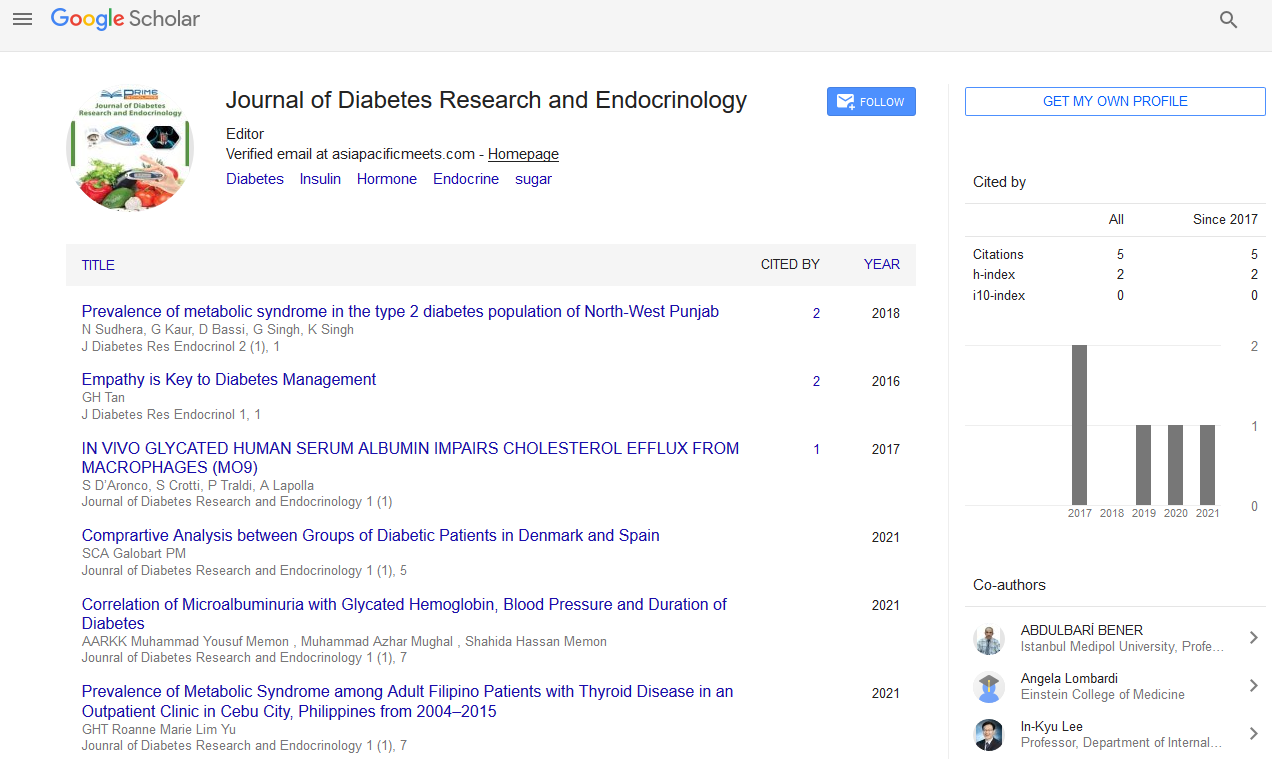Commentary - (2024) Volume 8, Issue 1
Continuous Glucose Monitoring: Revolutionizing Diabetes Management
Mia Walker*
Department of Endocrinology, Buckingham University, UK
*Correspondence:
Mia Walker,
Department of Endocrinology, Buckingham University,
UK,
Email:
Received: 28-Feb-2024, Manuscript No. IPJDRE-24-20061;
Editor assigned: 01-Mar-2024, Pre QC No. IPJDRE-24-20061 (PQ);
Reviewed: 15-Mar-2024, QC No. IPJDRE-24-20061;
Revised: 20-Mar-2024, Manuscript No. IPJDRE-24-20061 (R);
Published:
27-Mar-2024, DOI: 10.36648/ipjdre.08.01.05
Description
Diabetes management has undergone a remarkable
transformation with the advent of Continuous Glucose
Monitoring (CGM) systems. CGM technology provides realtime
data on glucose levels, empowering individuals with
diabetes to make informed decisions about their treatment
regimen, leading to better glycaemic control and improved
quality of life. This article explores the significance of CGM
in revolutionizing diabetes management and its impact on
patient outcomes. Traditional glucose monitoring methods,
such as finger stick testing with a glucometer, offer only
snapshots of blood glucose levels at specific points in time.
In contrast, CGM systems continuously measure interstitial
glucose levels using a tiny sensor inserted under the skin. These
sensors, typically worn on the abdomen or arm, communicate
wirelessly with a receiver or smartphone, providing real-time
glucose readings every few minutes. CGM provides continuous
insight into glucose fluctuations throughout the day and night,
offering a comprehensive view of glycaemic patterns. CGM
alerts users to impending hypoglycaemia (low blood sugar)
and hyperglycaemia (high blood sugar) trends, allowing for
proactive intervention to prevent severe glucose excursions.
Armed with real-time data, individuals with diabetes and
their healthcare providers can adjust insulin doses, dietary
choices, and physical activity levels more effectively, optimizing
glycaemic control. CGM systems help mitigate the risk of
hypoglycaemia by providing early warnings and trends, enabling
users to take corrective action promptly. By minimizing the
need for frequent finger stick testing and reducing the fear of
hypoglycaemia, CGM technology improves the overall quality
of life for individuals with diabetes. Studies have demonstrated
that CGM use is associated with improved glycaemic control,
as evidenced by reductions in HbA1c levels, fewer episodes
of hypoglycaemia, and less glycaemic variability. By enabling
tighter glycaemic control and reducing the incidence of
hypoglycaemia and hyperglycaemia, CGM technology may
help mitigate the risk of long-term diabetes complications,
such as retinopathy, nephropathy, and neuropathy. CGM
data allows for personalized diabetes management strategies
tailored to individual needs, preferences, and lifestyle factors,
leading to more effective and patient-centric care. CGM
empowers individuals with diabetes to take an active role in
managing their condition, fostering greater engagement, selfawareness,
and adherence to treatment regimens. While CGM
technology has revolutionized diabetes management, ongoing
innovation is essential to address existing challenges and
expand its potential benefits. Improvements in sensor accuracy
and reliability are crucial for ensuring the trustworthiness of
CGM data and optimizing treatment decisions. Making CGM
technology more accessible and affordable for all individuals
with diabetes remains a priority to ensure equitable access
to this life-changing technology. The integration of CGM with
automated insulin delivery systems, such as closed-loop
insulin pumps, holds promise for further optimizing glycaemic
control and reducing the burden of diabetes management.
Comprehensive education and training programs are essential
to empower individuals with diabetes and healthcare providers
with the knowledge and skills needed to effectively utilize
CGM technology. Continuous glucose monitoring represents
a paradigm shift in diabetes management, offering realtime
insights, personalized care, and improved outcomes for
individuals living with diabetes. By harnessing the power of
CGM technology and addressing remaining challenges, we can
continue to advance the standard of care and enhance the lives
of millions affected by diabetes worldwide.
Acknowledgement
None.
Conflict Of Interest
The author’s declared that they have no conflict of interest.
Citation: Walker M (2024) Continuous Glucose Monitoring: Revolutionizing Diabetes Management. J Diab Res Endocrinol. 8:05.
Copyright: © 2024 Walker M. This is an open-access article distributed under the terms of the Creative Commons Attribution License, which permits unrestricted use, distribution, and reproduction in any medium, provided the original author and source are credited.

